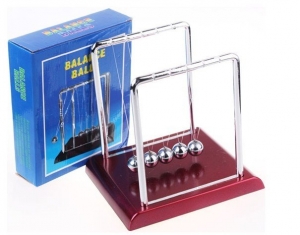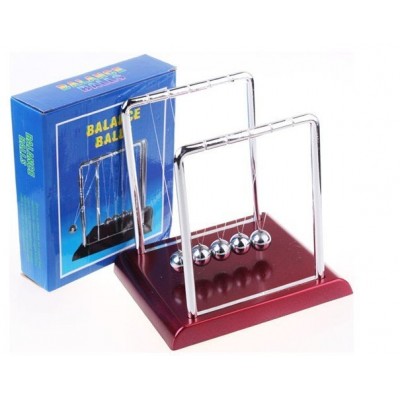- AIRPLANE
- Anatomy Models
- Angry Birds
- ASSEMBLING & BUILDING BLOCKS
- BOATS
- Telescopes
- Bikes, Tricycle & Ride Ons
- BINOCULARS
- Remote Control Cars & Trucks
- DIY ART & CRAFT
- EDUCATIONAL GAMES
- GLOBES
- HELICOPTER
- MAISTO TOYS & General Toys
- MICROSCOPES
- PUZZLES
- QUADCOPTER
- SCALE MODEL
- SCIENCE KITS
- SCIENCE TOYS
- BOARD GAMES
- Track & Train Sets
- Musical Toys
- BowArrow, Guns & Bat Ball
Balance Balls Newtons Cradle 5.5"
Availability: In Stock
Shipping Charge : Rs.75.00
Estimated Arrival: : 02 to 07 Working days
Construction:-
A typical Newton's cradle consists of a series of identically sized metal balls suspended in a Plastic frame so that they are just touching each other at rest. Each ball is attached to the frame by two wires of equal length angled away from each other. This restricts the pendulums' movements to the same plane.
Action:-
If one ball is pulled away and is let to fall, it strikes the first ball in the series and comes to nearly a dead stop. The ball on the opposite side acquires most of the velocity and almost instantly swings in an arc almost as high as the release height of the last ball. This shows that the final ball receives most of the energy and momentum that was in the first ball. The impact produces a compression wave that propagates through the intermediate balls. Any efficiently elastic material such as steel will do this as long as the kinetic energy is temporarily stored as potential energy in the compression of the material rather than being lost as heat.
With two balls dropped, exactly two balls on the opposite side swing out and back. With three balls dropped, three balls will swing back and forth, with the central ball appearing to swing without interruption.
History:-
Christiaan Huygens used pendulums to study collisions. His work, De Motu Corporum ex Percussione (On the Motion of Bodies by Collision) published posthumously in 1703, contains a version of Newton's first law and discusses the collision of suspended bodies including two bodies of equal mass with the motion of the moving body being transferred to the one at rest.
The principle demonstrated by the device, the law of impacts between bodies, was first demonstrated by the French physicist Abb� Mariotte in the 17th century.[5][6] Newton acknowledged Mariotte's work, among that of others, in his Principia.
Physics Explanation:-
Newton's cradle can be modeled with simple physics and minor errors if it is incorrectly assumed the balls always collide in pairs. If one ball strikes 4 stationary balls that are already touching, the simplification is unable to explain the resulting movements in all 5 balls, which are not due to friction losses. For example, in a real Newton's cradle the 4th has some movement and the first ball has a slight reverse movement. All the animations in this article show idealized action (simple solution) that only occurs if the balls are not touching initially and only collide in pairs.
Applications:-
The most common application is that of a desktop executive toy. Another use is as an educational physics demonstration, as an example of conservation of momentum and conservation of energy.
A similar principle, the propagation of waves in solids, was used in the Constantinesco Synchronization gear system for propeller / gun synchronizers on early fighter aircraft.[further explanation needed]
Invention and Design:-
The experimental use of pendulum devices, to demonstrate the law of impacts between bodies, was first described by Mariotte in the 17th century.
There is much confusion over the origins of the modern Newton's cradle. Marius J. Morin has been credited as being the first to name and make this popular executive toy. However, in early 1967, an English actor, Simon Prebble, coined the name "Newton's cradle" (now used generically) for the wooden version manufactured by his company, Scientific Demonstrations Ltd. After some initial resistance from retailers, they were first sold by Harrods of London, thus creating the start of an enduring market for executive toys. Later a very successful chrome design for the Carnaby Street store Gear was created by the sculptor and future film director Richard Loncraine.
| Specifications | |
| Code | SKC22-10 |
| Product Name | Balance Balls Newtons Cradle 5.5" |
| Material | Plastic & Metal Balls |
| Age | 8Years |
| Product Dimensions | 13.0cm x 11.0cm x 14.0cm (Approximate size) |
| Box Dimensions | 14.0cm x 12.0cm x 4.0cm |
Powered by OpenCart Made by ThemeGlobal - OpenCart Template Club







